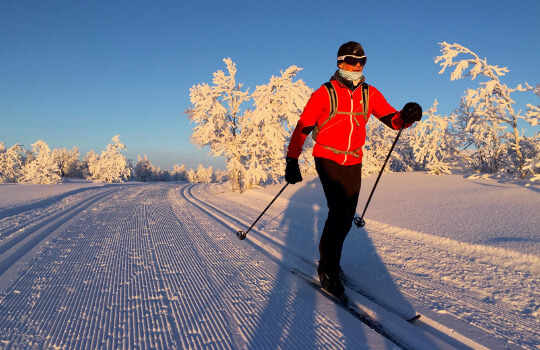We are proud to be the only adventure holiday company officially recognised by the British Association of Snowsport Instructors (BASI) as a Nordic Ski School. Cross-country skiing is at the heart of what we do, and we work exclusively with fully qualified professional ski instructors to ensure the highest standards of teaching and safety.
Whether you’re taking your first strides or looking to refine your technique, our cross-country skiing holidays offer expert instruction across all three Nordic skiing styles:
Classic: the traditional technique, resembling walking or running on skis.
Skate: a dynamic style echoing the motion of ice skating, perfect for building strength and rhythm.
Off-track: skiing beyond groomed trails, immersing yourself in the freedom of the winter wilderness.
With us, you’ll not only learn to ski - you’ll discover the beauty and variety of Nordic skiing in its purest form.
Cross-country skiing - also known as Nordic skiing, langlauf, ski de fond, or simply ski xc- is a unique way to explore winter landscapes. Unlike Alpine skiing, no lifts are used; instead, it’s your own rhythm and effort that carry you across snow-covered valleys, forests, and mountain trails.
On our cross-country ski holidays, you’ll be guided by first-class instructors who make learning fun and effective. Excellence in teaching is at the core of what we do - our co-founders themselves hold the highest cross-country ski qualification awarded by the International Ski Instructors Association.
For a greater understanding refer to our Guide to Cross Country Skiing or Frequently Asked Questions.

All our trips are available for private groups. If you would like to travel on different dates, or with family or friends on a bespoke trip, then please get in touch giving your preferred dates and itinerary.
View tailormade cross country skiingLearn to cross-country ski or improve your technique with our expert instruction.
Find out moreDevelop or learn a new ski skill. Experience the amazing 'skate' sensation!
Find out moreJourney point-to-point on our classic style ski tours all on prepared tracks.
Find out moreExplore away from the prepared trails hut-to-hut through an arctic wilderness.
Find out more| 7 DaysDURATION | IntermediateGRADE | £2495FROM |
Ski this legendary Arctic Crossing from Alta to near Kárášjohka and experience a landscape steeped in the history of the Sámi people. We will stay with Sámi families on our route and enjoy warm hospitality as we follow our dog sleds across this high plateau.
View trip| 8 DaysDURATION | IntermediateGRADE | £2145FROM |
Start 2026 with a week of cross-country skiing in the heart of the Norwegian mountains. Venabu plateau is a wild, remote and beautiful landscape on the edge of the Rondane National Park where you can experience the joy of skiing into a New Year.
View trip| 8 DaysDURATION | AdvancedGRADE | £2490FROM |
Crossing the Hardangervidda is one of the great classic ski journeys of the world. A wild, remote and immense plateau the Hardanger is world famous for its beauty, space and solitude. It is also home to wildlife such as arctic foxes, and beaver, and has the largest wild reindeer herds in Scandinavia.
View trip| 8 DaysDURATION | AdvancedGRADE | £2395FROM |
The Jotunheim, a Norwegian National Park, is also known as the 'Land of the Giants' as it contains the highest mountains in Norway. During this week long cross-country ski trip we explore the Sjodalen Valley and ski from one cosy mountain lodge to another. This ski route is very quiet and you will definitely be away from the crowds and experience the Norwegian wilderness.
View trip